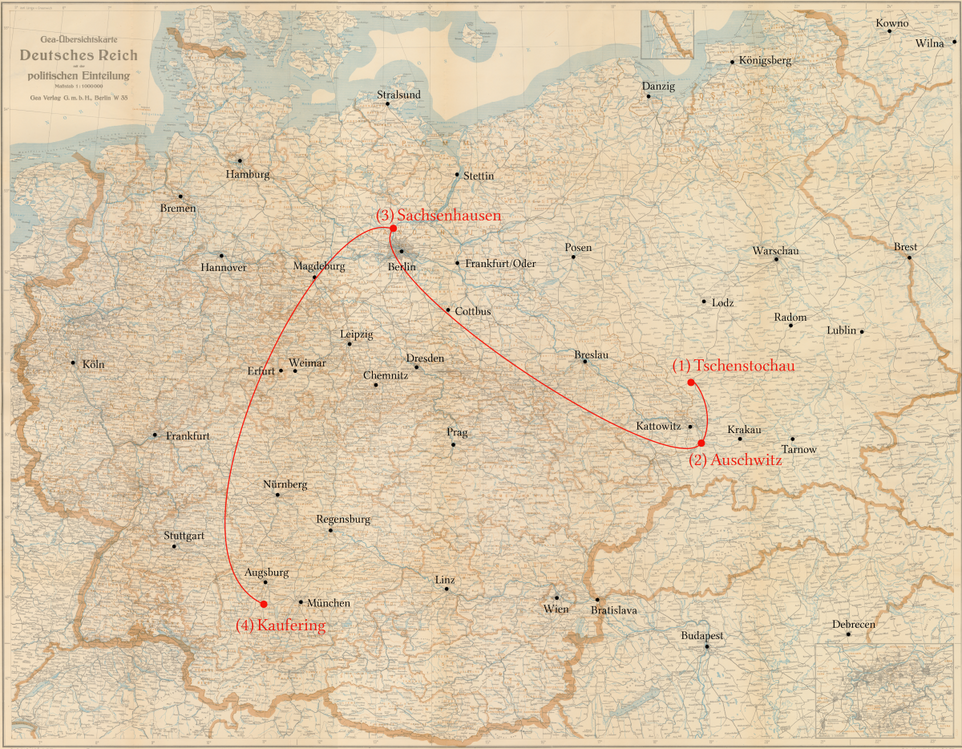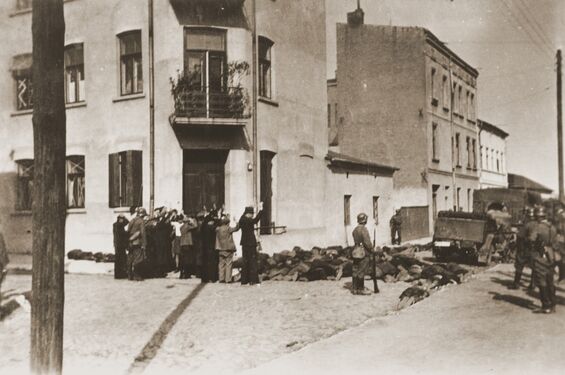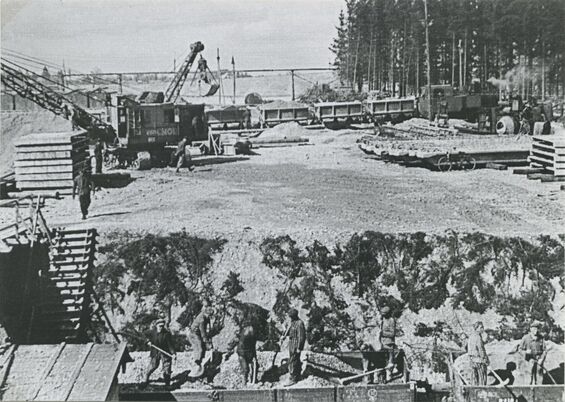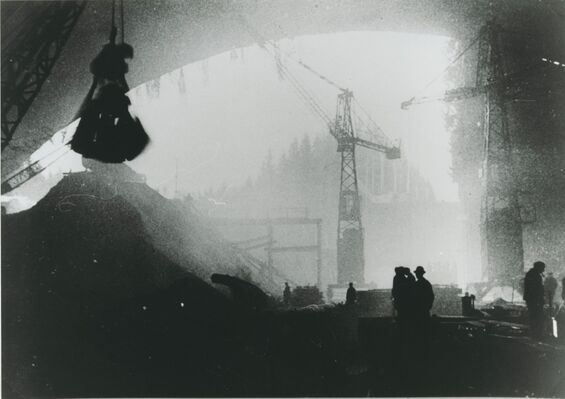The Biography of Max Kleinmann, Częstochowa
- born on 29 June 1922 in Częstochowa.
- from 1929 to 1936 he attended primary schools
- from 1936 to 1938 he was an apprentice mechanic and attended the craftsmen's school
- from 1 December 1939 he had to wear the Jewish star
- from March 1940 to March 1943 he was in the Częstochowa ghetto
- worked in the forced labour camp Czestochowa (HASAG) from March 1943 to July 1944
- was in Auschwitz concentration camp from July 1944 to October (November?) 1944, prisoner number B 1553
- was from 17 November 1944 to 29 April 1945 in the Dachau concentration camp / Kaufering satellite camp (Moll company)
- 1949: Emigration to the USA
Max Kleinman lost his parents, two brothers and a sister in the Holocaust. He was 17 when his persecution began.
Before the War
I am submitting this affidavit in connection with my application for compensation for damage to body and health. Before the outbreak of the persecution measures, I lived with my parents and siblings in Częstochowa. I enjoyed good health and was never seriously ill. After finishing Polish primary school, I became an apprentice mechanic and attended vocational school. My father was a tailor and my economic situation was satisfactory. When the Nazis occupied my homeland in 1939, my ordeal began.
Source: Unless otherwise stated: Konrad Kittl files, Max Kleinmann affidavit;
March 1940 to March 1943: Częstochowa ghetto
Even in the first few months I had to do various cleaning jobs and in winter I had to shovel snow for hours on end. Then came the ghetto. In the ghetto we lived in the most oppressive conditions, although I wasn't particularly tall for my age, I was made to do heavy labour. I was repeatedly harassed and beaten. I witnessed atrocities every day. We also suffered from great hunger as the food rations were miserable. But I got the biggest shock when my beloved parents, my two brothers and my sister were deported in September 1942. I never saw them again.
März 1943 - Juli 1944: HASAG Tschenstochau
I myself came to HASAG Pelserie and Rakow and had to work hard in day and night shifts in the munitions factory. My work consisted of cleaning cans. I was repeatedly beaten. One day, for no reason at all, every second one of 50 workers was taken out and shot. They didn't even say why. One day later they accused me of sabotage and beat me up.
July 1944 to Oktober 1944: Auschwitz
I was dragged from HASAG to the Auschwitz concentration camp. Here I was branded with the number B 1553. At first I was put in the children's block because they thought I was a child due to my short stature. I witnessed how all the children were dragged away during an operation. I hid together with eight other children. When the guards came looking for us, they found us and we were beaten up. I was bleeding from a wound on the back of my head and they gave me a bandage, but I tore it off the next day so as not to be selected.
17.11.1944 bis 29.4.1945 Kaufering
From here I was dragged to Dachau-Kaufering, where I had to do cement work for the Moll company despite my dilapidated condition. When I was liberated, I was infected with typhus fever. I immediately received medical help from US Army doctors
Max Kleinmann - witnesses
Siche Schwarc appeared as a witness for Max Kleinmann. Around 1954, he, Walter (formerly Wolf) Grayer, and Harry Gliklich explained their persecution
Being aware of the significance of a statutory declaration and the punishability of false statements, and having been advised that false statements may jeopardise our compensation claims, we hereby affirm in lieu of an oath as follows:
1. Siche (formerly Zysla) SCHHWARC, born on 21 March 1921 ibn Czenstochau, Poland, now residing in Brooklyn, New York. My compensation claim is pending in Munich under file number BEG 2472.
2. My name is Walter (formerly Wolf) Grayer, residing at 81 Crooke Avenue, Brooklyn, New York. I received the number Munich 93818/VII/27412 for my compensation claim, but as far as I know the matter has been referred to Trier, and I do not know the new file number.
3. My name is Harry Gliklich, I live at 3569 Broadway, New York. My compensation claim is registered in Munich. File number 12363/VI/3047.
We are neither related by birth nor marriage.
At the time of the German invasion, we three were living in Czestochowa. We all came from the same neighbourhood, in the district that was later enclosed as a ghetto.
From the end of 1939 we had to wear Jewish badges and do forced labour, in the early days not every day but by May 1940 at the latest we were doing it constantly, all day from morning to evening, 6 days a week. All three of us worked for the ‘water management’ company, we had to do drainage work and mostly worked in the water.
I, Gliklich, was transferred to PRZEROW in 1941, while we, Schwarc and Grayer, remained in Czenstochau. Nevertheless, we were able to maintain contact with each other, because on Sundays, 10-15 people from PRZEROW would come to Czenstochau on a one-day Sunday holiday, including me, Gliklich, not every Sunday, but quite often. When we were allowed to go to Czestochowa, we received a special pass, and of course we were identified by the armbands. In any case, we stayed in contact this way and knew where each other was. Towards the beginning of 1942, I, Gliklich, came to Czestochowa and from then on we were all together again.
A few months later we all came to Blizyn, where we remained for over a year. There we all worked in the quarry, I, Schwarc, in the sawmill during the last months. We stayed there until the autumn of 1943, then we all came to Auschwitz, not together on the same transport, but around the same time, we all met again in Auschwitz.
We were in Auschwitz until late autumn 1944 and were then sent to Dachau-Kaufering, again not on the same transport, but separately, I via Sachsenhausen. Anyway, we all came together again in Kaufering, around November 1944. We stayed there until the evacuation towards the end of the war, then we were put on the march and liberated together in Buchberg near Wolfratshausen, that was on 1 or 2 May 1945.
We can therefore truthfully confirm to each other that we were deprived of our freedom together as stated above.
Ziche Schwarc file,Landesamt für Finanzen, Labndesentschädigungsamt, Munich, file reference BEG 2472
Akte Ziche Schwarc, Landesamt für Finanzzen, Landesentschädigungsamt, München, Aktenzeichen BEG 23472
Notes
Office for Compensation
Stuttgart ES 95 (0) – I – ERS/Me 1964-?
Picture Credits
- A group of Jewish men, who have been rounded-up by German soldiers, await execution on a street in Czestochowa. In front of them lie the corpses of those who were shot earlier. Credit: United States Holocaust Memorial Museum, courtesy of B.Ashley Grimes II, Archival Signature 26825
- Stadtarchiv Landsberg, Bild Bunker_033
- Stadtarchiv Landsberg, Bild Bunker_025



